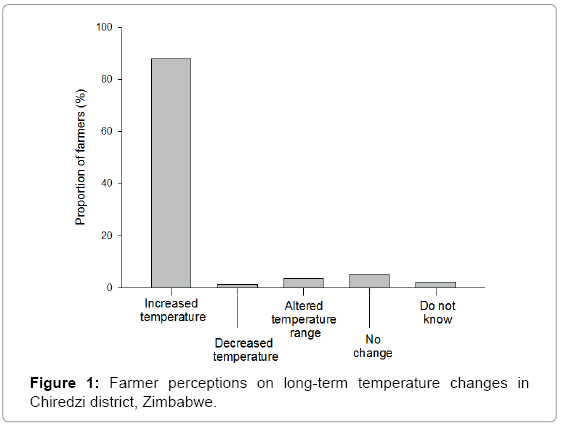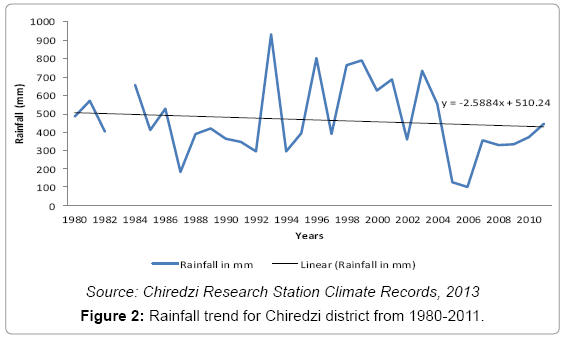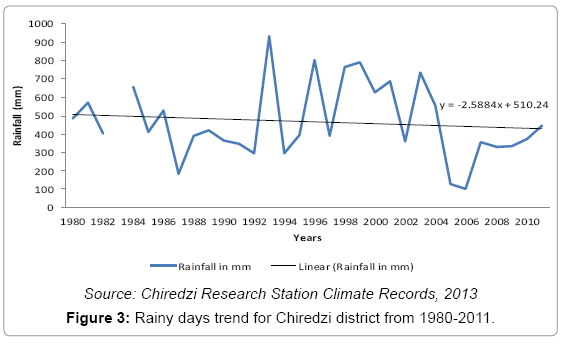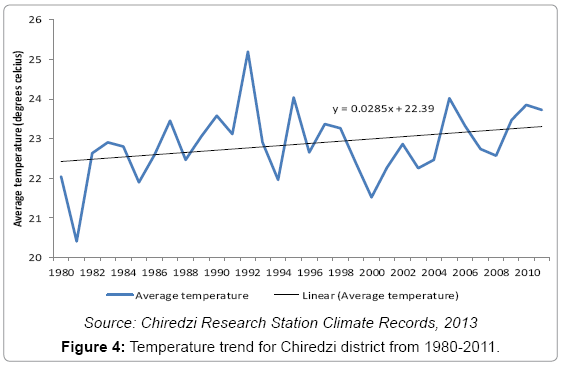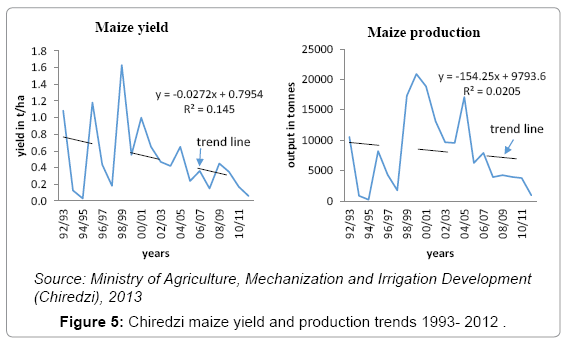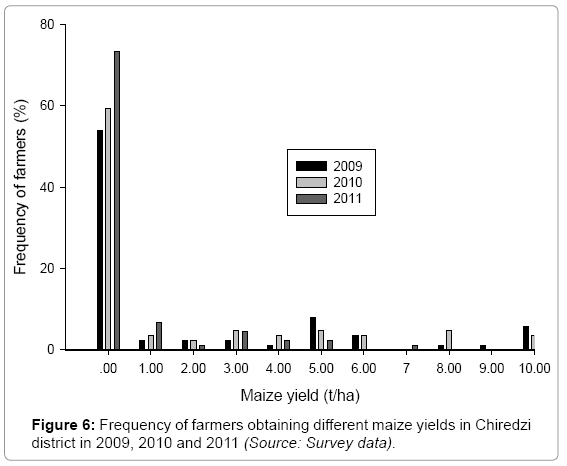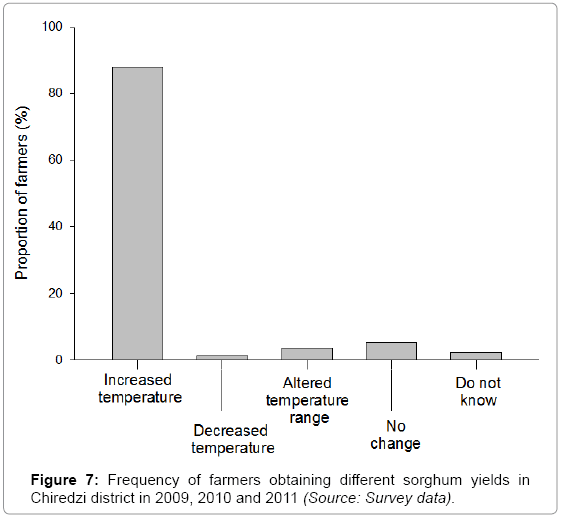Smallholder Farmer Perceptions on Climate Change and Variability: A Predisposition for their Subsequent Adaptation Strategies
Received: 27-Apr-2015 / Accepted Date: 28-May-2015 / Published Date: 08-Jun-2015 DOI: 10.4172/2157-7617.1000277
Abstract
Smallholder farmers are facing several climate-related challenges. Projected changes in climate are expected to aggravate the existing challenges. This study was conducted in Chiredzi district, Masvingo, Zimbabwe. The study objective was to examine farmer perceptions on climate variability, current adaptive strategies and establish factors influencing smallholder farmers’ adaptation to climate change. A survey was conducted with 100 randomly selected respondents from four wards. Additionally, data was collected through focus group discussions and key informant interviews. The results showed that farmers perceived that there has been a decrease in annual rainfall and an increase in average temperatures. A linear trend analysis of rainfall and temperature data from 1980 to 2011 corroborated the farmers’ perceptions. Farmers’ adaptation options included adjusting planting dates and crop diversification. Off-farm income has reduced the dependence of the farmers on agriculture. A multinomial regression analysis showed that socioeconomic factors such as gender, age, number of cattle owned, land size and average crop yields influenced farmer adaptation strategies. The study concludes that although farmers are diverse in their socio-economic attributes, they exhibit homogeneous perceptions on changes in climate, which are consistent with observations of empirical climate data. These perceptions help to shape smallholder farmer coping and adaptation strategies.
Keywords: Climate change and variability; Farmer perception; Adaptation; Adaptive capacity
11386Introduction
Sub Saharan Africa (SSA) is one of the most vulnerable regions to climate change in the world. It is particularly vulnerable to the impacts of climate change due to widespread poverty, recurrent droughts, inequitable land distribution, over-dependence on rain-fed agriculture and low adaptive capacity [1,2]. Because of climate change, the areas traditionally suitable for agriculture, the length of growing seasons and crop yields are decreasing and varying from year-to-year, with serious consequences for food security [3,4]. By 2050, average temperatures over Zimbabwe are projected to be 2–4°C higher and rainfall 10–20% less than the 1961-1990 baselines [3-5]. Simulation models show annual rainfall declining by 5–20% of the 1961-90 average by 2080 in all Zimbabwe’s major river basins [3]. Agriculture, an important sector in Zimbabwe, has been identified as the sector most vulnerable to these climate changes. Given these predictions of climate change, the smallholder farmer in the marginal areas needs to adapt to climate change and variability.
Climate change and variability is one of the biggest global threats to agricultural production for the current and future generations. There is evidence that climate change has greatly modified the hydrological cycles, rainfall and temperature patterns in many parts of the world [6]. The effects of climate change and variability, however, vary across regions, farming systems, households and individuals. The combined effects of all these occurrences put a strain on the livelihoods of smallholder farmers, especially in developing countries. The vulnerability of developing countries to climate risks is based on the reliance of these countries on rain fed agriculture [6]. Without any adaptation, climate change and variability would cause a decline in annual gross domestic product of 4% in Africa [7]. The situation is of greater concern in Sub-Saharan Africa where per capita food production has been declining [7].
The vulnerability, coping and adaptive capacity and resilience of farmers to climate change and variability in semi-arid systems could be addressed through different adaptation strategies. However, farmers’ adaptation decisions are guided by their perception to climate change and variability, and climate related risks. Smallholder farmers need to be able to identify the changes already taking place in their areas and institute appropriate coping and adaptation strategies. A farmers’ ability to perceive climate pre-empt to their choice to cope and adapt [8,9]. The coping and adaptation strategies of smallholder farmers depend, to a large extent, on their perception knowledge level [9]. In essence, adaptation to climate change and variability requires farmers to first notice that the climates has changed, and then identify and implement potential useful adaptations [10].
Consequently, without adaptation, the vulnerability of agro-based communal households would increase with climate variability and change. However, these smallholder farming communities have coped and adapted to the effects of climate change and variability over the years[11]. This creates the need for understanding the perception of the smallholder farmer to the impacts of climate change and variability at local level [12,13].
Over the years, smallholder farmers in Zimbabwe and other parts of Southern Africa have devised adaptation strategies to climate change and variability [14]. These include crop diversification, planting different crop varieties, complementing farm activities with non-farm activities (such as curio sales), and changing planting dates, increasing the use of irrigation, and water and soil conservation techniques [14]. However, smallholder farmers’ decisions to implement meaningful agricultural adaptation strategies is largely influenced by their perceptions of weather, among other factors [15,16]. The farmers’ perception of climate change influences their propensity to respond to the strength of a climate signal and subsequent adaptation [17]. The impacts of climate change and variability cannot be understood without considering farmer perceptions, that influence how climate signals are felt and how they impact on farm level decisions.
The objective of this study was to infer the perceptions of smallholder farmers on climate change and variability, and its influence on subsequent adaptation strategies in Chiredzi District, Zimbabwe.
Materials and Methods
Description of the study area
The study was conducted in Chiredzi District in Masvingo Province, Zimbabwe, which lies between 18°55'S and 29°49'E. Chiredzi District was chosen as it falls within the arid and semi-arid areas. It lies largely in Natural Region V, a region that experiences the lowest amount of rainfall of less than 400 mm/year in most years [18,19]. The rainfall is often erratic, with widespread droughts in most years. Temperatures are always quite high in summer (day temperatures often over 39oC in summer) causing evaporation losses of 10–13 mm/day. The annual mean, maximum and minimum mean monthly temperatures in the district are 24.8°C, 27.4°C (November) and 22.3°C (July), respectively.
Data collection and analysis
Four out of the 24 wards in rural Chiredzi district, two on either side of the Runde River, were chosen for this study. Five villages were randomly chosen from each ward and farmer lists for each village were supplied by the agricultural extension officers. Within the randomly selected villages, five farmers were randomly selected using the farmer lists in each village to give 25 respondents per ward. Quantitative and qualitative data was collected using a structured questionnaire, focus group discussions and key informant interviews [20]. Seven key informant interviews were done with key district personnel as well as village heads and the elderly. A focus group discussion was done in each ward. A total of 100 households were interviewed using the questionnaire. Quantitative data collected through the structured questionnaire was analysed using the Statistical Package for Social Sciences (SPSS) [21]. Linear trend analyses of climate time series data was done on climate and, multinomial logit regression analysis of determinants of adaptation options was also done. The multinomial logit analysis model for climate adaptation strategy specifies the following relationship between the probability of choosing option Ai and the set of explanatory variables X as:

Where βj is a vector of coefficients on each of the independent variables x.
Results
Household and demographic information
Male household decision makers made up 65% of the respondents while 35% were female. Sixty seven percent of the respondent farmers were married with 10%, 22% and 1% being widowed, single and divorced, respectively. The average age of the respondent farmers was about 49 years, with a range of between 17 and 80 years (Table 1). The results also revealed that a high proportion of the farmers (38.2%) had primary education while 26.8% had up to secondary education. Only about 3% of the farmers had some tertiary education. However, 32% of the farmers did not have any formal education.
| Age of head of household (years) | |
|---|---|
| Mean | 48.84 |
| Std. Error of Mean | 1.44 |
| Median | 50 |
| Std. Deviation | 14.14 |
| Minimum | 17 |
| Maximum | 80 |
Table 1: Age of household head.
The average household size was seven persons, an average of three males and four females per household. However, each household had an average of four members being fit to work in the fields and members who were either too young or chronically ill to work explain the difference. A significant proportion, 77.3%, of the household heads was full time farmers while the remainder were involved in formal employment (5.15%) or self-employment (6.19%). The remainder, 11.36%, were not part of any of the categories indicated. Seventy nine percent of the farmers have income of less than $100 per month with 28% of these having no reliable source of this income. The major sources of income were crop (average $51 per month) and livestock (mainly goats averaging $48 per month) sales, as well as part-time work (averaging $45 month income).
Farmer perceptions on long-term climatic changes
Figure 1 shows the respondent farmers’ perception on longterm temperature trends in Chiredzi district. More than 87% of the respondents perceive that there has been an increase in average temperatures in the past 10-20 years. The results also indicated that most farmers (85.7%) perceive that precipitation has been declining in the past 10-20 years. This implies that the district is becoming more and more prone to droughts due to declining rainfall as perceived by the farmers. About 9.2% of the farmers perceive that, in the past 10-20 years, there has been a noticeable change in the onset and duration of the rains, while 4.1% and 1% either perceive no change or do not know whether there were any changes in rainfall, respectively.
The trend analysis for rainfall in Chiredzi district is shown in Figure 2. The analysis shows a negative trend in total rainfall in the district. The decrease in rainfall is 2.59 mm/year. The trend analysis for rainy days (Figure 3) shows that there is also a negative trend of 0.43 days/year (1980–2011). Figure 4 shows an increase in average temperatures for Chiredzi district of 0.03°C/year from 1980 to 2011.
Farmer perceptions on crop yields
The results indicate that 76% of the farmers believed that maize yields have been declining over the past 20 years (Figure 5). Twentyfour percent either observed no changes or thought the maize yields had remained static. Analysis of average yield per hectare and total maize output for Chiredzi district confirmed the farmers’ perceptions (Figure 6). While the area under maize and sorghum has been constant, the average area put to cotton per household has been marginally increasing over the years from 0.25 ha in 2009, to 0.31 ha in 2010 and 0.35 ha in 2011). An analysis of the main cereal crop yields showed prevalence of farmers obtaining very low average yields of less than one tonne per hectare over a three-year period (2009–2011) in Chiredzi district for maize (Figure 6) and sorghum (Figure 7).
Farmer perceptions on other climate change indices
Smallholder farmers in Chiredzi perceive decreased bushy growth (38.1%), reduced herbaceous cover (37.1%), disappearance of wetlands (8.3%) and 16.5% did not observe any changes. About 34% of the farmers perceive decreased crop heights while about 30% perceive shorter germination periods and variable maturation periods. About 62% of the farmers perceive an increase in crop pest abundance while about 2% and 6% perceive a changed seasonality of some crop pests and emergence of new crop pest species, respectively. About 46% of the farmers perceive increased crop disease prevalence while 5% perceive changed seasonality of crop diseases and emergence of new crop diseases. However, about 39% of the farmers perceived no change or a decrease in crop disease prevalence, severity and seasonality. Thirty one percent of farmers perceive increased weed abundance, 11% perceive new weed species and 3% perceive changed seasonality of weeds. About half of the farmers perceive increased livestock pest abundance while those farmers who perceive changed seasonality of livestock pests and emergence of new livestock pests were 4% and 2%, respectively. About 43% of the farmers perceived an increase in livestock disease prevalence and severity while 3% perceive new livestock disease types. However, 47% of the farmers perceive no changes in livestock diseases or they are not sure if any changes in livestock disease prevalence, severity and seasonality, have taken place. These results indicate that smallholder communal farmers are aware of impacts of climate change on crops, crops pests, livestock and the environment.
Smallholder farmers’ adaptation strategies to climate change and variability
Adaptation to climate change and variability through adjustment of agronomic practices (cropping adaptations) under dry land conditions was the main coping and adaptation mechanism in Chiredzi district (55.1% of smallholder farmers) (Table 2). A combination of agronomic and livestock practices was a prevalent strategy (26.9%). Livestock adaptations only without crops were carried out by 15.4% of the smallholder farmers. Adaptation using socio-cultural beliefs and practices was the least common strategy used by smallholder farmers (2.6%) (Table 2). However, it is important to note the importance of social beliefs in climate adaptation, as they are the basis of indigenous adaptation strategies to climate change and variability.
| Adaptation measure | Percentage of adopters (%) |
|---|---|
| Different crop varieties | 51.55 |
| Crop diversification (Different crops) | 63.92 |
| New planting dates | 68.04 |
| Shortening the length of growing period | 69.07 |
| Mixing dry land and home gardens | 83.51 |
| Mixing farming and non-farming activities | 83.72 |
| Use of irrigation (home gardens) | 80.41 |
| Use of chemicals, fertilisers, manure and pesticides | 77.32 |
| Increasing water conservation on farms | 60.82 |
| Increasing soil conservation on farms | 65.98 |
| Shading and sheltering young plants | 74.23 |
| Mixing crops and livestock (diversification) | 74.23 |
| Livestock diversification (different animals) | 82.47 |
| Adjusting livestock management practises | 82.47 |
| Insurance | 0 |
| Use of prayer and socio-cultural adaptations | 83.81 |
Table 2: Adaptation measures used by smallholder farmers in Chiredzi.
Factors influencing farmers’ adaptation options
Table 3 shows a multinomial logit regression analysis of the factors influencing the choice of farmers’ adaptation strategy. Farmer socioeconomic attributes and farmer perception to climate change and variability significantly influenced the type of agricultural adaptation chosen by the farmer in response to a changing climate (Table 3). Male-headed households significantly improved chances of adopting agronomic practices and a combination of agronomic and livestock practices, but would not adapt to climate change through the adoption of livestock practices only (Table 3). Despite cattle being important in traditional ceremonies, the number of cattle owned had no significant effect on the adoption of agronomic and socio-cultural practices for climate change adaptation. However, the number of cattle owned had significant impact on the adoption of agronomic practices only, livestock practices only and a combination of agronomic and livestock practices.
| Variable | Agronomic practices only | Livestock practices only | Agronomic and livestock practices | Agronomic and socio-cultural beliefs/practices | ||||
|---|---|---|---|---|---|---|---|---|
| Coeff. | P-level | Coeff. | P-level | Coeff. | P-level | Coeff. | P-level | |
| Intercept | -2.008 | 0.017** | -2.649 | 0.093* | -5.004 | 0.015** | -4.233 | 0.993 |
| Gender | 0.541 | 0.050* | -2.905 | 0.094* | 3.157 | 0.014** | -5.015 | 0.989 |
| Age | 0.660 | 0.061* | 2.495 | 0.095* | 0.052 | 0.018** | 1.630 | 0.098* |
| Employment status | -1.896 | 0.084* | 2.21 | 0.091* | 0.030 | 0.097* | 1.237 | 0.988 |
| Farm size-dry land | -0.06 | 0.037** | -3.05 | 0.051* | 0.122 | 0.070* | -2.072 | 0.986 |
| Members fit for agriculture | 0.155 | 0.003*** | 0.115 | 0.017** | 0.223 | 0.000*** | 0.217 | 0.011** |
| Cattle owned | 0.041 | 0.077** | 7.433 | 0.072* | 0.080 | 0.057* | -5.466 | 0.994 |
| Maize yield | 0.068 | 0.000*** | 5.272 | 0.916 | 0.032 | 0.076* | 2.035 | 0.083* |
| Cotton yield | 14.188 | 0.048** | 3.661 | 0.854 | 13.797 | 0.000*** | 3.582 | 0.099* |
| Perception on climate | 0.874 | 0.005*** | 1.032 | 0.604 | 0.173 | 0.040** | 0.839 | 0.079* |
| Base category | No adaptation | |||||||
| Likelihood Ratio Chi² | 61.966 | |||||||
| Pseudo R² | 0.615 | |||||||
| Log likelihood | -110.821 | |||||||
Significant at ***1%, **5%, and *10% probability level, respectively
Table 3: Socioeconomic and perception determinants of climate adaptation options by smallholder farmers in Chiredzi district.
Discussion
In this study, the basis of farmers perceiving a changing climate is declining rainfall and increasing average temperatures over the years (Figure 1). This corroborates with measured annual rainfall and temperatures for Chiredzi district (Figures 2, 3 and 4). The mean annual rainfall for Chiredzi district was 466.49 mm, fluctuating between 101.50 mm and 932.30 mm in the period between 1980 and 2011 (Figure 2). Trend analysis of the empirical rainfall data shows an average annual decrease in rainfall of 2.59 mm. The trend analysis for rainy days (Figure 3) shows that there is also a negative trend of 0.43 days per year from 1980 up to 2011. This means that the number of raining days per each season is decreasing. Majule et al. [22] reported similar results of declining precipitation in Malawi and Tanzania by 0.85 mm per year over the last 30 years. An analysis of mean annual temperatures in Chiredzi showed an annual increase of 0.03°C (Figure 4). These results are consistent with findings by Solh and Saxena [23] and IPCC climate predictions for southern Africa [6]. Maddison [24] obtained similar results which showed that a significant proportion of farmers in Africa are noticing increasing temperatures. Correct perceptions of a problem and the awareness of the potential benefits of redressing the problem is a critical determinant of adoption of agricultural adaptation initiatives [14,17,25]. Maddison [24] and Vedwan and Rhoades [26] noted that farmers’ perceptions on changes in temperature and rainfall are critical for farm-level adaptation decision-making. This is supported by Gould et al. [27] who found a significantly positive relationship between farmer perceptions and awareness and the adoption of soil conservation measures. Results from the current study showed that those farmers who have perceptions that are in line with the actual trends in climatic changes will adopt measures to cope and adapt to climate change and variability (Table 3).
The results showed a continuous decline in maize yields (Figure 5). This could be a result of the average growing conditions over the years (Figures 2 and 4). The decline in maize yield is supported by other reports that have shown a decrease in maize yields as a critical impact of climate change and variability in southern Africa [17,28,29]. From the multinomial logit analysis, the average yield of maize showed a very significant and positive effect on the probability of adopting agronomic practices only (Table 3). It also showed a significant positive effect on the chances of adopting combinations of agronomic and livestock practices as well as agronomic and socio-cultural practices. Therefore, increasing maize yield when agronomic practices are adopted results in farmers practising more robust adaptation strategies (Table 3). Increasing maize yield is associated with improved household food security [30]. This could be attributed to increased availability of labour for implementing agricultural adaptation options.
Gender of the household head has a positive and significant influence on the choice of agronomic and a combination of agronomic and livestock adaptation options (Table 3). This implies that gender of the household head plays a critical role in farm decision-making process. Several studies report that gender is a critical variable affecting decisions at farm level. In a study in southern Alberta, United States,Chiotti et al. [31] showed that female farmers were more likely to adopt new natural resource management techniques than their male counterparts. In many rural African farming communities, married male farmers usually do not discuss farming decisions with their wives [32]. They would rather discuss farming decisions with other male farmers [32]. The marital status of the household head, however, may be critical in climate adaptation. This is because if married farmers can discuss farming decisions with their spouses they could make better adaptation decisions than single, widowed or divorced farmers [32,33].
The current study showed that age of farmer influences the farmer’s choice of adaption options (Table 3). This agrees with most studies that indicate a significant positive relationship between age of farmer and level of adoption of conservation measures on the farms [33,34]. In some studies, however, age was shown to have an insignificant effect on farmers’ decision-making relating to adoption of technology. This negative relationship could be due to farmers being reluctant to undertake new innovations, as they grew older due to risk-aversion tendencies [35].
The relatively high proportion (32%) of farmers without any formal education might be due to the non-formal education among the predominantly Shangani community in Chiredzi district. It could also be due to children being introduced into farming at a very tender age, as common in many rural communities in Zimbabwe [36]. It is assumed that those who manage to proceed further with their education could be from wealthier families. A number of studies show that the level of education correlates to level of knowledge and the simplicity of making sound decisions [37,38]. Higher levels of education coupled with more farming experience should improve farmer’s perceptions on climate change. In contrast, however, Clay et al. [31] discovered that education did not play an important role in determining whether a particular farmer adopted any technology or not. In some instances though, education has a negative effect on adoption of technology [27]. Therefore, the choice of coping and adaptation options could be determined by the smallholder farmers’ knowledge based on tradition, education level and experience.
Previous studies give conflicting effects of household size in explaining adoption of technology by farmers. Dolisca et al. [37], notes that bigger household sizes allow farming households to adopt adaptation strategies that require a lot of labour per unit of land. Bigger families may also invest extra labour into other non-farming activities to earn extra income [14]. The current study showed that households with more members who are fit and able to work in agriculture will adapt more than those households with fewer members who are fit enough to work (Table 3). Varadan and Kumar [39] obtained similar results although in their findings the probability of adaptation only showed significance in the adoption of drought tolerant crop varieties. Agronomic practices such as implementing soil and water conservation techniques on farms, use of chemicals, organic manure and fertilizers, shading and sheltering young plants, diversifying crops and livestock have high labour requirements. A large family size will have a positive influence on the adoption of these adaptation strategies and techniques.
These results showed that as the number of cattle owned increases, smallholder farmers’ likelihood of adopting agronomic practices only, livestock practices only or a combination of the two practices increases significantly (Table 3). This is probably because cattle provide draft power for crop production. Considering also that cattle are a sign of wealth in many rural communities, those farmers with more cattle are expected to have more resources and better access to adaptation information [32]. However, the number of cattle owned has a negative impact on the probability of adopting a combination of agronomic and socio-cultural practices as adaptation strategy (Table 3). This could be because in many rural communities have traditional cultural practices which use cattle for ritual purposes. Smallholder farmers are less likely to adopt such an adaptation strategy, which reduce their wealth.
Being a full-time farmer has a very significant but negative effect on the likelihood of adoption of agronomic practices only (Table 3). This indicates that full-time farmers may lack sources of off farm income to help implement some adaptation strategies [40]. Unlike part-time farmers who have access to external sources of income, full-time farmers may not be able to buy improved seeds or diversify cropping owing to the low yields obtained from cropping (for example, Figures 6 and 7). However, being a full-time farmer shows a significant positive effect on the probability of adopting livestock practices only and on the probability of adoption of a combination of agronomic and livestock practices. This may be because full-time farmers are able to allocate optimum time for both livestock and agronomic practices and then use cattle for draft power.
Table 3 also showed that a unit increase in the dry land area owned by the farmer would reduce the chances of adopting agronomic practices only, livestock practices only and the combination of agronomic and socio-cultural practices. This could be due to the difficulty to carry out meaningful agricultural adaptations like soil and water conservation techniques on larger dry land farm sizes owing to the labour intensive nature of such operations [41]. The size of the dry land area owned, however, has a significant positive effect on the adoption of a combination of agronomic and livestock practices. Farmers who own larger dry land farms therefore have a higher propensity to invest in agronomic and livestock practices as an adaptation strategy to the changing climate.
Farmer perceptions can reveal the farmer’s access to information on climate change, the knowledge of the farmer, access to extension services and farmer-to-farmer extension as well as the farmer’s social networks [24]. Farmer perceptions are significant on adopting agronomic practices, followed by adoption of a combination of agronomic and livestock practices and finally the adoption of a combination of agronomic and socio-cultural beliefs/practices. Despite a positive influence of farmers’ perceptions on the likelihood of adoption of livestock practices, this relationship is however not significant. Nhemachena and Hassan [14] also revealed that, farmers who notice changes in climate had higher chances of taking up and implementing measures to respond to the changing climate. As noted by Madison [24], farmer perception on climate change is a critical component of farmers’ decision-making process regarding the farmer’s decision to adopt any agricultural adaptation response. The various, suitable crop and livestock management practices which farmers could take should be based on climate forecasts for each location so as to have meaningful impact [42,43].
Conclusion
This study revealed that farmers have noticed decline in rainfall and increase in average temperatures over the years. These perceptions have influenced adoption of agronomic practices, livestock practices or socio-cultural practices to cope and adapt to climate change and variability. While climate change and variability is an environmental problem, the scope of its impacts is strongly determined by underlying socioeconomic variables. The study concludes that, perceiving that the climate is changing increases the probability of uptake of certain adaptation strategies by indigenous smallholder farmers. Development of participatory approaches as tools to integrate knowledge systems by mapping perceptions of climate change and variability at the local level to document changes in crop and livestock production systems will increase adaptive capacity.
Acknowledgements
The researchers would like to acknowledge financial support from the National Research Foundation (NRF), South Africa.
References
- Intergovernmental Panel on Climate Change (IPCC) (1998) The Regional Impacts of Climate Change: An Assessment of Vulnerability. Special Report of IPCC Working Group II. In Watson RT, Zinyowera MC, and Moss RH (edn). Intergovernmental Panel on Climate Change, Cambridge University Press, Cambridge, United Kingdom and New York, NY, USA, p. 517.
- Hulme M (1996) Climate change and Southern Africa: an exploration of some potential impacts and implications in the SADC region. Climatic Research Unit and World Wide Fund for Nature,pp.104.
- Lobell DB, Burke MB, Tebaldi C, Mastrandrea MD, Falcon WP, et al. (2008) Prioritizing climate change adaptation needs for food security in 2030. Sci 31: 607-610.
- Nyong A (2005) Impacts of climate change in the tropics: the African experience. A keynote presentation to symposium on ‘Avoiding dangerous climate change’, London, Met Office.
- Unganai LS (2006) Historic and Future Climate Change in Zimbabwe. Climate Res 6: 137-145.
- Intergovernmental Panel on Climate Change (IPCC) (2007) Climate Change: Synthesis Report. Contributions of Working Groups I, II and III to the Fourth Assessment Report of the Intergovernmental Panel on Climate Change. IPCC,Geneva.
- World Bank (2010) World Development Report 2010. World Bank, Washington, D.C.
- Moyo M, Mvumi BM, Kunzekweguta M, Mazvimavi R, Craufurd P, et al. (2012) Farmers’ perceptions on climate change and variability in semi-arid Zimbabwe in relation to climatology evidence. African Crop Sci J 20: 317-335.
- Kihupi ML, Chingonikaya EE, Mahonge C (2015) Smallholder Farmers’ Perception of Climate Change Versus Meteorological Data in Semi-arid Areas of Iringa District, Tanzania. J Environ Earth Sci 5: 137.
- Adger WN, Arnell NW, Tompkins EL (2005) Successful adaptation to climate change across scales. Global Environ Change 15: 77-86.
- Li C, Tang Y, Luo H, Di B, Zhang L (2013) Local farmers’ perceptions of climate change and local adaptive strategies: a case study from the Middle YarlungZangbo River Valley, Tibet, China. J Environ Management 52: 894-906.
- Shemdoe RS (2011) Trackingeffectiveindigenous adaptation strategies onimpactsofclimatevariabilityon food securityandhealthofsubsistencefarmersinTanzania.African Technology Policy Studies (ATPS) Network working paper series No.51. ISBN: 978-9966-1552-0-7UNESCO.
- Kassie BT, Hengsdijk H, Rötter R, Kahiluoto H, Asseng S, et al. (2013) Adapting to climate variability and change: experiences from cereal-based farming in the central rift and Kobo Valleys, Ethiopia. J Environ Manage 52: 1115-1131.
- Nhemachena C, Hassan R (2007) Micro-level analysis of farmers’ adaptation to climate change in Southern Africa. IFPRI Discussion Paper No. 00714. International Food Policy Research Institute, Washington, DC.
- Patt A, Gwata C (2002) Effective seasonal climate forecast applications: examining constraints for subsistence farmers in Zimbabwe. Global Environmental Change: Human and Policy Dimensions 12: 185-195.
- Patt A, Suarez P, Gwata CC (2005) Effects of Seasonal Climate Forecasts and Participatory Workshops among Subsistence Farmers in Zimbabwe.Proceedings of the National Academy of Sciences (PNAS) 102: 12623-12628.
- Bryan E, Deressa TT, Gbetibouo GA, Ringler C (2009) Adaptation to climate change in Ethiopia and South Africa: options and constraints. Environ Sci Policy 12: 413-426.
- Moyo S (2000) Zimbabwe environmental dilemma: balancing resource inequities. Harare, Zimbabwe. Environmental Research Organization, pp. 161.
- Vincent V, Thomas RG (1960) An agro-ecological survey of Southern Rhodesia: Part I agro-ecological survey. Salisbury, Government Printers.
- Bryman A (2008) Social Research Methods (3rdedn.) Oxford University Press,Oxford.
- Majule AE, Ngongondo C, Kallanda-Sabola M, Lamboll R, Stathers T, et al. (2008) Strengthening local Agricultural Innovation Systems in Less and More Favoured Areas of Tanzania and Malawi to Adapt to Climate Change and Variability: Perceptions, impacts, vulnerability and adaptation. Research Abstracts. Issue Number 3: Sokoine University of Agriculture: ISBN: 9987-38-9.
- Solh M, Saxena MC (2011) Food security and climate change in dry areas: proceedings of an International Conference, 1-4 February 2010, Amman, Jordan. PO Box 5466, Aleppo, Syria: International Center for Agricultural Research in the Dry Areas (ICARDA).
- Maddison D (2006) The perception of and adaptation to climate change in Africa. CEEPA Discussion Paper No. 10. Centre for Environmental Economics and Policy in Africa, University of Pretoria.
- Vermeulen S, Campbell BM, Ingram JSI (2012) Climate change and food systems. Annual Rev Environ Resour 37: 195-222.
- Vedwan N, Rhoades RE (2001) Climate change in the Western Himalayas of India: a study of local perception and response. Climatic Res 19: 109-117.
- Gould BW, Saupe WE, Klemme RM (1989) Conservation tillage: The role of farm and operator characteristics and the perception of soil erosion. Land Economics 65: 167-82.
- Fuhrer J, Gregory PJ (2014) Climate Change Impact and Adaptation in Agricultural Systems: Soil Ecosystem Management in Sustainable Agriculture. CABI.
- Bryan E, Ringler C, Okoba B, Roncoli C, Silvestri S, et al. (2013) Adapting agriculture to climate change in Kenya: household strategies and determinants. J Environ Manage 114: 26-35.
- Valdivia C, Seth A, Gilles JL, GarcÃa M, Jiménez E, et al. (2010) Adapting to Climate Change in Andean Ecosystems: Landscapes, Capitals, and Perceptions Shaping Rural Livelihood Strategies and Linking Knowledge Systems. Annals of the Association of American Geographers 100: 818 - 834.
- Chiotti Q, Johnston T, Smit B, Ebel B (1997) Agricultural Response to Climate Change: A preliminary Investigation of Farm-level Adaptation in Southern Alberta. In:Ilbery B, Chiotti Q, Rickard T (eds.)Agricultural restructuring and sustainability: a geographical perspective.
- Obayelu OA, Adepoju AO, Idowu T (2014) Factors influencing farmers’ choices of adaptation to climate change in Ekiti State, Nigeria. J Agr Environ Int Develop 108: 3 - 16.
- Apata TG (2011) Factors influencing the perception and choice of adaptation measures to climate change among farmers in Nigeria. Evidence from farm households in Southwest Nigeria. Environ Econ 2: 74-83.
- Bayard B, Jolly CM, Shannon DA (2007) The economics of adoption and management of alley cropping in Haiti. J Environ Manage 84: 62-70.
- Burton M, Rigby D, Young T (1999) Analysis of the determinants of adoption of organic horticultural techniques in the UK. J Agr Econ 50: 47-63.
- Manjengwa J, Matema C, Mataruka J, Tirivanhu T, Tamanikwa M, et al. (2014) Children and climate change in Zimbabwe. UNICEF/IES, Harare, Zimbabwe.
- Dolisca F, Carter RD, McDaniel JM, Shannon DA, Jolly CM (2006) Factors influencing farmers’ participation in forestry management programs: A case study from Haiti. Forest Ecol Manage 236: 324-31.
- Anley Y, Bogale A, Haile-Gabriel A (2007) Adoption decision and use intensity of soil and water conservation measures by smallholder subsistence farmers in Dedo district, Western Ethiopia. Land Degradation Develop 18: 289-302.
- Varadan RJ, Kumar P (2014) Indigenous knowledge about climate change: Validating the perceptions of dryland farmers in Tamil Nadu. Indian J Traditional Knowl 13: 390-397.
- Enete AA, Madu II, Mojekwu JC, Onyekuru AN, Onwubuya EA, et al. (2011) Indigenous Agricultural Adaptation to Climate Change: Study of Southeast Nigeria. Published by the African Technology Policy Studies Network, ISBN: 978-9966-030-00-9.
- Turral H, Burke J, Faurès J (2011) Climate change, water and food security. FAO water reports. Food and Agriculture Organization of the United Nations, Rome.
- Fankhauser S (1995) Valuing Climate Change: The Economics of the Greenhouse, Earthscan, London.
- Mano R, Nhemachena C (2007) Assessment of the Economic Impacts of Climate Change on Agriculture in Zimbabwe: A Ricardian Approach. Policy Research Working Paper, p. 4292.
Citation: Jiri O, Mafongoya P, Chivenge P (2015) Smallholder Farmer Perceptions on Climate Change and Variability: A Predisposition for their Subsequent Adaptation Strategies. J Earth Sci Clim Change 6: 277. DOI: 10.4172/2157-7617.1000277
Copyright: ©2015 Jiri O, et al. This is an open-access article distributed under the terms of the Creative Commons Attribution License, which permits unrestricted use, distribution, and reproduction in any medium, provided the original author and source are credited.
Share This Article
Recommended Journals
Open Access Journals
Article Tools
Article Usage
- Total views: 18075
- [From(publication date): 6-2015 - Apr 03, 2025]
- Breakdown by view type
- HTML page views: 13039
- PDF downloads: 5036

